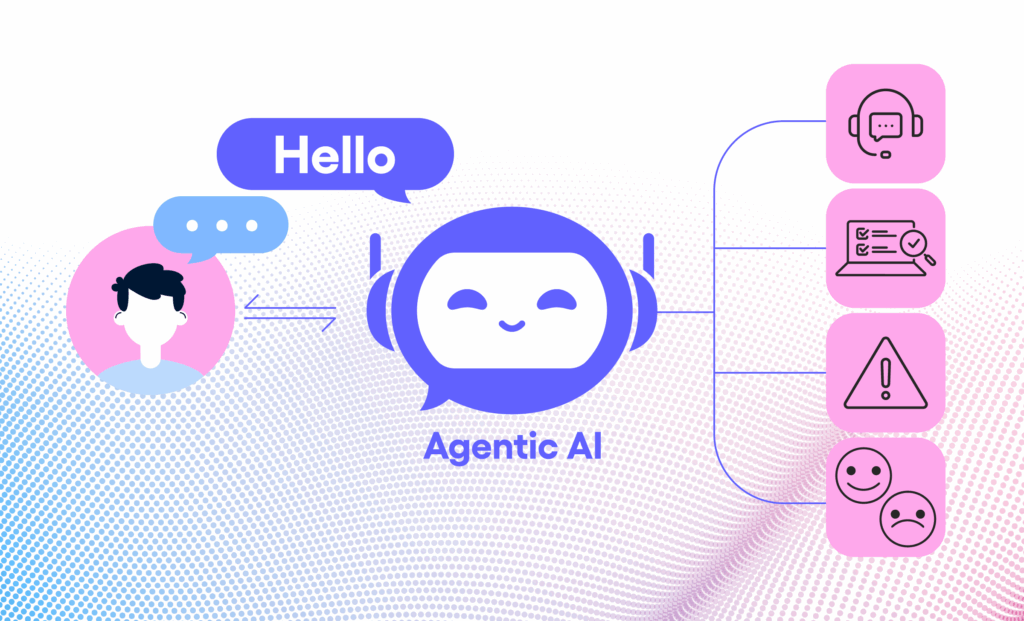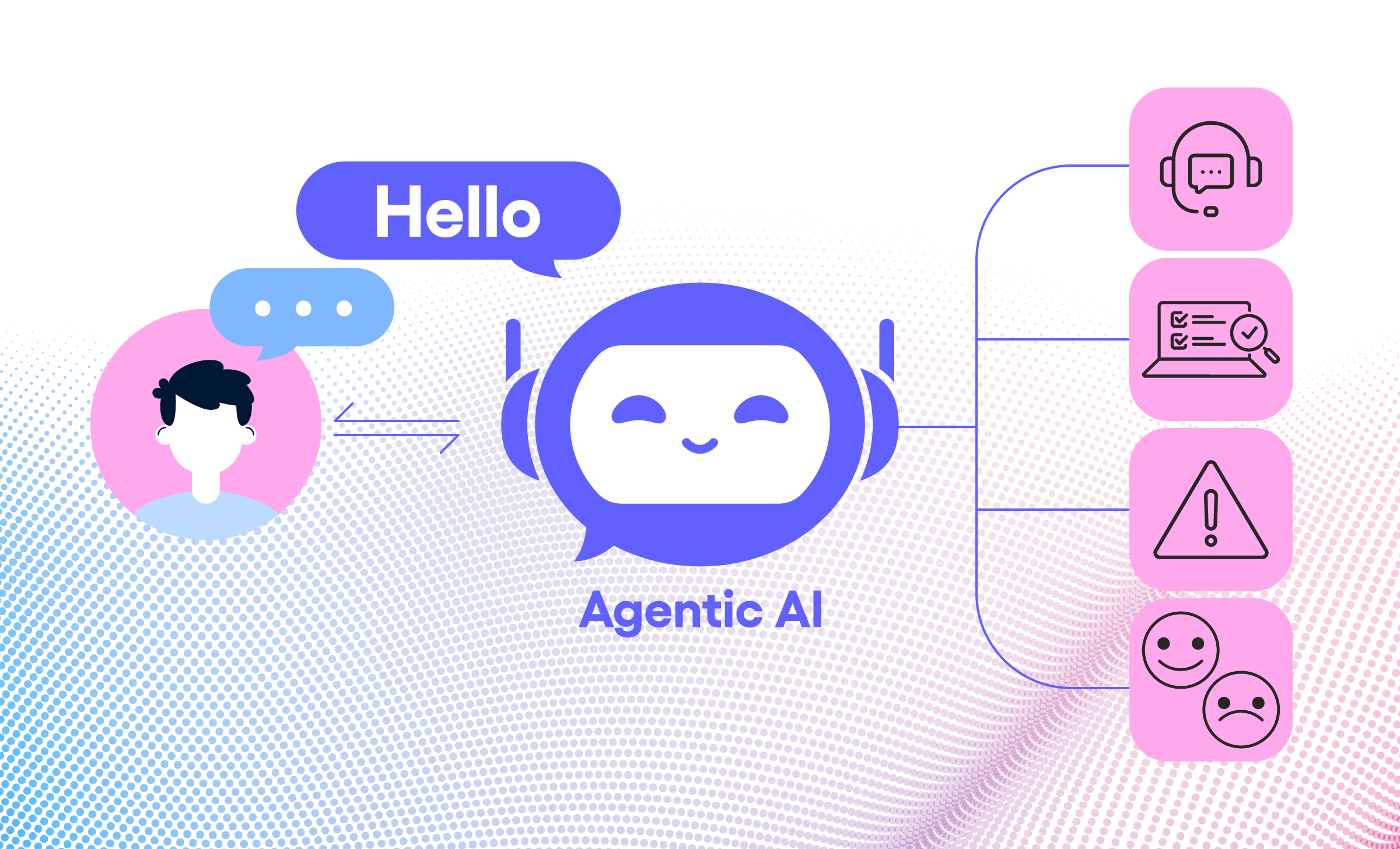Businesses have automated processes for decades, and many now use AI in routine work such as summarizing documents, drafting replies, or generating reports. These systems remain reactive: they execute tasks only when prompted, and their output ends with the completion of each request.
Agentic AI marks a structural shift into proactive intelligence. Rather than producing isolated responses, agents interpret goals, decide what actions to take, and execute them within defined parameters. They do not possess greater intelligence than the language models that power them. Their advantage lies in configuration. Agents integrate reasoning engines with memory, data access, and external tools, allowing them to achieve objectives through controlled autonomy.
This article explains how AI agents operate, where they fit within existing digital systems, and how they generate measurable business value. The aim is to describe agentic systems as they are being deployed today as a centrepiece to enterprise automation.
TMO specializes in delivering Digital Transformation Solutions that help organizations design and implement intelligent systems and deliver measurable business outcomes.
How AI Agents Work: The Loop and Its Core Capabilities
An AI agent is a system that can perceive information from its environment, reason about what to do, and take actions toward a goal with a defined level of autonomy. It differs from a conventional automation script or chatbot in one crucial way: it can make decisions in context, not just execute preprogrammed rules.
To achieve this, an AI agent operates through a 5-step feedback loop that allows it to handle goals instead of isolated instructions:
| Capability | Description | Example |
|---|---|---|
| 1. Perception | Gathers and interprets input. | Reading an email or a customer order. |
| 2. Reasoning | Decides what to do next. | Determining how to respond to an issue. |
| 3. Action | Executes via connected tools or APIs. | Sending a refund, updating a record. |
| 4. Feedback | Monitors outcomes. | Checking if the issue was resolved. |
| 5. Memory | Stores context for future actions. | Remembering prior customer interactions. |
1. Perception
The process begins with perception. The agent collects information from its environment: customer messages, product data, or analytics feeds. What the agent can “see” depends entirely on its inputs or "sensors" (APIs, connectors, or data pipelines) that expose relevant information:
| Function | Examples | Role |
|---|---|---|
| Data Connectors | API endpoints, webhooks, SDKs | Expose structured and unstructured data to the agent |
| Retrieval Tools | Database queries, search indexes | Provide targeted context |
| Input Interfaces | Chat windows, dashboards | Collect human inputs in structured form |
In enterprise use, these may include CRM entries, transaction records, support tickets, or analytics dashboards. What the agent can perceive defines its competence. Poor data access or fragmented sources limit its awareness before reasoning even begins.
2. Reasoning
Guided by context and task instructions, the agent then interprets this data, evaluates its goal, and determines a suitable course of action. This reasoning can be seen more as structured logic applied to a defined scope, rather than intelligence in abstract.
| Component | Description |
|---|---|
| LLM + Prompt | Core reasoning engine and instruction layer |
| Policies / Guardrails | Business rules and safety boundaries |
| Memory Access | Retrieves prior context to inform reasoning |
Most agents use large language models (LLMs, such as ChatGPT) as their reasoning core, guided by prompts that define objectives, constraints, and tone. Reasoning quality depends less on the model’s size than on how it’s configured and grounded. Clear prompts and access to relevant memory prevent the agent from producing arbitrary or disconnected decisions.
3. Action
In the action stage, the agent executes the plan through connected tool (outputs or "actuators") by updating databases, sending messages, or triggering workflows. These actions have real operational effects, which is why guardrails and permission layers are essential.
This is also the stage where orchestration tools such as Zapier or n8n come into play. They coordinate actions, manage dependencies, and ensure that results are executed in the correct sequence.
| Function | Examples | Purpose |
|---|---|---|
| Actuators | API calls, workflow triggers, scripts | Carry out the agent’s decisions |
| Orchestration | Zapier, n8n, LangChain | Manage process flow and state |
| Integration Layer | ERP, CRM, Analytics tools | Bridge reasoning with execution |
4. Feedback
After acting, the agent enters the feedback stage. It evaluates the outcome by checking whether the intended result occurred. This may involve comparing response data, verifying a system update, or reviewing confirmation logs.
| Function | Description | Example |
|---|---|---|
| Feedback Evaluation | Confirms success or failure of actions | Check API response, verify record update |
Feedback closes the loop and ensures the system remains accountable to measurable results via "evaluators", that is, a component or process that validates outcomes, often implemented as a rule check or performance metric.
5. Memory
The final stage is learning. Here, the agent records the experience in memory, storing contextual details such as task inputs, results, and adjustments made. Over time, these stored experiences allow the agent to maintain continuity across sessions and refine its behavior through accumulated context used for recall and pattern recognition.
| Function | Description | Example |
|---|---|---|
| Memory Store | Saves past results and context | Vector database, structured log |
| Learning Cycle | Refines behavior over time | Use previous outcomes to guide reasoning |
Note that the agent doesn’t retrain itself, rather accumulates context, making its next decision better informed. Over time, this continuity creates predictability and resilience: two traits essential for enterprise adoption.
This perception–action loop is what gives agents their practical autonomy. Instead of waiting for instructions, they can interpret goals, perform multi-step reasoning, and adjust based on results. Within business systems, this means repetitive coordination and decision-making can occur automatically, faster, more consistently, and within a controlled framework. Consider an order management agent in an eCommerce setting:
- Input: Detects a new order in the sales database.
- Reasoning: Confirms stock availability and identifies that part of the order must ship from another warehouse.
- Action: Notifies logistics, updates the order status, and triggers shipment preparation.
- Feedback: Monitors delivery confirmation and updates tracking information.
- Learning: Records any delays or fulfillment errors for performance tracking.
The agent has not only completed the task but maintained oversight and data continuity, reducing manual coordination and error risk.
Agentic AI in Customer Service: 4 Use Cases for Support EfficiencyFrom support, to sentiment analysis, documentation, and issue detection, we explore the top applications for Agentic AI in customer service.
3 Types of AI Agents and How They Connect to Your Systems
AI agents do not live in isolation. They exist inside the digital environments where business data, workflows, and users already interact. Their “location” is defined by what they can access: data inputs, execution tools, and permissions.
Understanding where agents reside helps clarify how are they built and most importantly, how they actually operate inside modern organizations:
Embedded Agents: Visible Interfaces
These agents live inside user-facing applications like CRMs, dashboards, analytics tools, or eCommerce platforms. They appear as assistants or copilots that respond to instructions, retrieve information, or perform specific tasks within the interface. Examples include:
- A custom GPT inside a helpdesk system summarizing support tickets.
- A sales copilot inside a CRM drafting follow-ups or proposals.
These agents are visible, conversational, and collaborative. They extend human capability directly where work happens.
Background Agents: Invisible Automation
Background agents run silently behind the scenes, moving data between systems, monitor workflows, and trigger processes automatically. Their function depends on orchestration platforms such as Zapier, n8n, or LangChain, which coordinate how information flows and how actions are executed:
- Listen for triggers (a form submission, a data update).
- Execute multi-step sequences.
- Handle retries or fallbacks when something fails.
Users rarely see them, but they shape operational consistency and make the difference between an instant update and a broken sync.
Platform-Level Agents: System Orchestrators
At a higher level, some agents span multiple systems. These are orchestration or middleware agents that combine reasoning with process control. They manage tasks such as:
- Synchronizing data between finance, inventory, and CRM systems.
- Routing actions between specialized sub-agents.
- Applying business rules and monitoring compliance.
Platform-level agents often operate as the connective tissue of an enterprise stack, coordinating smaller agents and enforcing shared logic.
How Multi-Agent Systems Collaborate
A single agent can manage a defined workflow, but most business processes involve multiple objectives, dependencies, and roles. Managing these requires coordination among agents: systems that interact with one another, share context, and divide tasks. This collective structure is referred to as a multi-agent system.
1. Structure and Coordination
Multi-agent systems distribute intelligence rather than centralize it. Each agent is assigned a function: retrieving data, analyzing information, generating insights, or executing tasks. They communicate through shared data stores or orchestration frameworks that handle message passing and dependencies. The most common coordination models are:
- Centralized: A single coordinator agent manages sub-agents and assigns tasks.
- Decentralized: Agents operate independently but share information through a common environment or memory.
- Hybrid: A hierarchical structure where specialized agents collaborate under domain-specific supervision.
Centralized systems simplify management and auditing. Decentralized ones scale more flexibly and continue operating if one agent fails. The right approach depends on task complexity, data sensitivity, and oversight requirements.
2. Roles Within Multi-Agent Systems
Agents can be organized by function, mirroring human team structures:
| Role | Purpose | Example Task |
|---|---|---|
| Coordinator | Plans and delegates work to others | Assigns tickets to specialized sub-agents |
| Researcher / Retriever | Gathers information and context | Retrieves data from APIs or databases |
| Analyst / Planner | Interprets data and generates insights | Produces summaries or recommendations |
| Executor | Carries out actions on systems | Updates records, sends notifications |
| Evaluator | Monitors performance and verifies outcomes | Checks if goals were met or errors occurred |
These agents may use shared memory or message queues to maintain awareness of what others are doing. This prevents duplication, maintains consistency, and enables iterative collaboration where each agent contributing to a part of the whole process.
3. Managing Risk and Oversight
Coordination increases capability but also complexity. Each additional agent introduces new dependencies and potential failure points. Well-designed multi-agent systems include audit trails, version control, and sandboxed permissions to ensure that decisions remain transparent and reversible. Human oversight typically remains part of the loop for critical decisions, even when agents execute autonomously.
4. Strategic Implications
Multi-agent systems shift automation from task completion to process management. Instead of a single workflow agent repeating a sequence, organizations can design entire operational ecosystems where agents collaborate across departments or functions. This architecture supports adaptability: new agents can be added without redesigning the system, and existing ones can specialize or be retrained for new objectives.
In practice, this transforms automation from linear scripts into dynamic networks where each component intelligent enough to understand its role, communicate with others, and contribute to a shared outcome.
5. Example: Coordinated Customer Resolution
Let's review the customer service agent from the example above. In a more complex system, a single request may trigger cooperation among several agents:
- A retriever agent gathers past communication and transaction history.
- A reasoning agent diagnoses the issue and proposes a resolution.
- An executor agent processes refunds or updates records.
- An evaluator agent checks for completion and satisfaction metrics.
- A coordinator oversees the sequence, ensuring all steps are completed within defined parameters.
The agents share a unified context through memory and logs, maintaining continuity across multiple cycles.
Designing and Managing Agentic Systems
The key to building successful AI systems is about designing interactions that start with clear objectives, defined boundaries, and reliable access to data and tools. The process resembles systems engineering more than software development, and can be broken down into 6 steps:
- Define the Scope: Every agent should have a specific goal and a measurable outcome. Overly broad mandates lead to unpredictable behavior. The first step is to identify where the agent will operate (what systems it can access, what tasks it will perform, and how its results will be evaluated).
- Build Around Existing Infrastructure: Agents should integrate with the systems already in use rather than replace them. API accessibility, data quality, and workflow clarity are prerequisites. A stable environment ensures that reasoning can translate cleanly into action.
- Implement Guardrails: Autonomy requires control. Each agent needs clear limits on what it can change, who it reports to, and when it should stop or ask for input. Guardrails can be implemented through permissions, rule-based triggers, or validation steps. Transparency and reversibility matter more than full independence.
- Monitor and Iterate: Agents should be evaluated continuously. Logs, metrics, and feedback loops provide the data needed to refine prompts, adjust access levels, and correct drift. Performance reviews for agents are no different in principle from those for employees: they confirm whether goals are met and what needs to improve.
- Coordinate Through Orchestration: As more agents are introduced, orchestration frameworks become essential. They manage task dependencies, prioritize requests, and resolve conflicts between agents. Centralized oversight helps maintain consistency across distributed logic and prevents overlapping actions.
- Start Small, Scale Intentionally: Pilot projects should focus on narrow, measurable use cases: automating a reporting process, reconciling inventory updates, or assisting customer responses. Early results inform both design and governance standards. Once stable, agents can be replicated or extended into adjacent workflows.
Agentic systems are not built by adding intelligence to software. They are built by connecting decision loops to reliable infrastructure. Clarity of scope, discipline in integration, and continuous oversight are what turn an intelligent tool into a dependable system.
Transforming Process Automation with Agentic AI and TMO
AI agents represent the next stage of digital transformation. As businesses evolve, operational advantage will depend less on isolated automation and more on how systems think, act, and coordinate together.
Implementing agentic systems requires alignment between technology and process. Organizations must define where autonomy adds value, how to maintain oversight, and how information should flow across platforms.
If you’re exploring how AI agents could fit into your organization, reach out to us for a consultation on what an agentic system might look like for your specific workflow or platform.
At TMO, we help enterprises bridge that design gap. Our work focuses on integrating intelligent workflows into existing architectures: connecting data, reasoning, and execution layers through structured, scalable systems. Whether the goal is to improve customer experience, streamline operations, or deploy AI across departments, the approach is the same: build clarity first, then intelligence.














